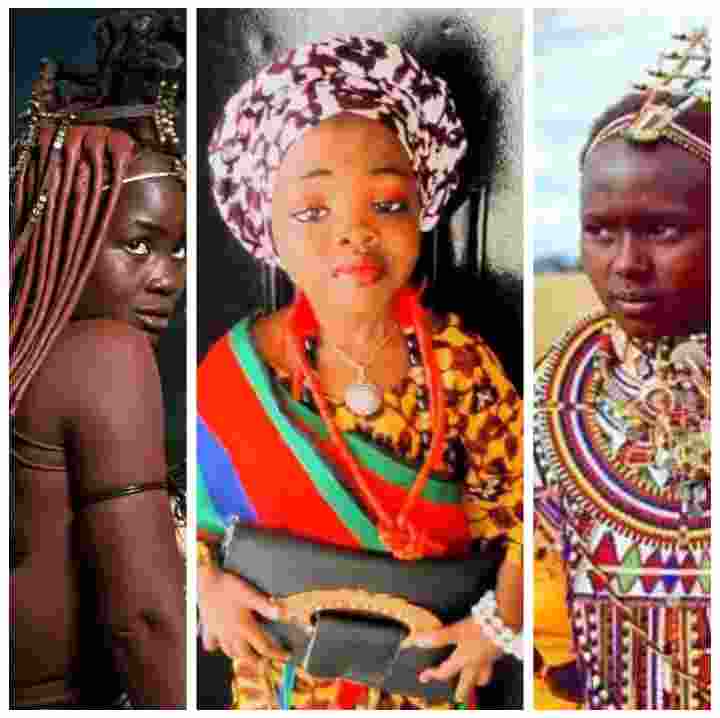Africa is a continent rich in cultural diversity, and one of the most fascinating aspects of this diversity is the traditional clothing worn by various tribes and ethnic groups. Each tribe has its unique style, colors, and patterns, representing its history, values, and identity. In this article, we will explore the top 10 most beautiful traditional dresses in Africa, the tribes that wear them, their history, and the population of each tribe.
1. Nupe Tribe – Nigeria
The Nupe tribe, located in North Central Nigeria, is known for their colorful and intricately woven traditional clothing. The women wear Eko-Kpara and Kpasa Colourful (Blue, Red and Green), another Africa dresses belong to Nupe’s are Gboko Taba, Nnadzwa Ebwa, Ede Zwangun, Ede Donko, their Kpasa is often made from fabric, adorned with vibrant patterns and embroidery. The Nupe men wear Ewo-ko, a flowing robe, often paired with a matching cap. With a population of over 8 million, the Nupe people have a rich cultural heritage, including their beads and wood art, music, drums and traditional festivals. You can find Nupe people in Niger state, Kwara state, Abuja, Kogi state, Edo state and Kaduna state.
2. Maasai Tribe – Kenya and Tanzania
The Maasai tribe, known for their vibrant red clothing, is one of the most iconic tribes in Africa. The traditional dress of the Maasai people consists of a bright red shuka (a rectangular cloth) wrapped around the body, adorned with intricate beadwork and jewelry. The Maasai are a semi-nomadic tribe, primarily found in Kenya and Tanzania. With a population of approximately 1.5 million, they have managed to preserve their rich cultural heritage despite modern influences.
3. Himba Tribe – Namibia
The Himba tribe, residing in the remote regions of northern Namibia, is renowned for their unique traditional attire. The women of the Himba tribe wear a distinctive red ochre paste on their skin and hair, giving them a striking appearance. Their clothing consists of a goatskin skirt, adorned with shells, beads, and metal ornaments. The Himba people have a population of around 50,000, and their traditional dress is a symbol of their deep connection to their ancestral land.
4. Zulu Tribe – South Africa
The Zulu tribe, the largest ethnic group in South Africa, is known for their vibrant and colorful traditional clothing. The women wear intricately beaded aprons, called isidwaba, along with beaded necklaces and headdresses. The men wear animal skins and feathers, representing their warrior status. With a population of over 11 million, the Zulu people have a rich history of resistance against colonialism and have managed to preserve their cultural traditions.
5. Samburu Tribe – Kenya
The Samburu tribe, closely related to the Maasai, also reside in Kenya. Their traditional dress is similar to that of the Maasai, with a focus on bright colors and intricate beadwork. The women wear beaded necklaces, bracelets, and earrings, while the men wear colorful shukas and carry spears. With a population of around 300,000, the Samburu people have a strong sense of community and are known for their traditional ceremonies and rituals.
6. Xhosa Tribe – South Africa
The Xhosa tribe, located in the Eastern Cape region of South Africa, has a rich cultural heritage, including their traditional dress. The women wear vibrant, patterned skirts called isikhakha, along with colorful headscarves and beaded jewelry. The men wear a distinctive blanket, known as a kaross, and often carry a walking stick. With a population of over 8 million, the Xhosa people have played a significant role in South Africa’s history and continue to celebrate their traditions.
7. Tuareg Tribe – Sahara Desert
The Tuareg tribe, also known as the “Blue People” due to their indigo-dyed clothing, are nomadic people residing in the Sahara Desert. The men wear flowing robes called djellabas, often in shades of blue, along with turbans and veils to protect themselves from the harsh desert environment. The women wear colorful dresses and headscarves. With a population of approximately 2 million, the Tuareg people have a rich history of trade and are known for their unique music and storytelling traditions.
8. Ashanti Tribe – Ghana
The Ashanti tribe, located in Ghana, is renowned for their vibrant kente cloth, considered one of the most beautiful fabrics in Africa. The kente cloth is handwoven with intricate patterns and bright colors, often worn as a wrap or draped over the shoulder. The Ashanti people have a population of around 12 million and are known for their rich cultural heritage, including their traditional ceremonies and festivals.
9. Berber Tribe – North Africa
The Berber tribe, indigenous to North Africa, including countries like Morocco, Algeria, and Tunisia, have a diverse range of traditional clothing. The women often wear brightly colored dresses with intricate embroidery and silver jewelry, while the men wear hooded cloaks and turbans. The Berber people have a population of over 30 million and have a long history of resilience and cultural preservation.
10. San Tribe – Southern Africa
The San tribe, also known as the Bushmen, are one of the oldest indigenous groups in Southern Africa. Their traditional dress consists of animal skins and hides, providing protection from the harsh desert environment. The San people have a population of around 100,000 and have a deep connection to their ancestral lands, known for their rock art and hunting and gathering skills.
In conclusion, Africa is a continent brimming with cultural diversity, and the traditional dresses worn by various tribes are a testament to this richness. From the vibrant red clothing of the Maasai to the intricate beadwork of the Zulu, each tribe’s traditional dress represents their history, values, and identity. Exploring these beautiful traditional dresses offers a glimpse into the diverse and fascinating cultures of Africa.
